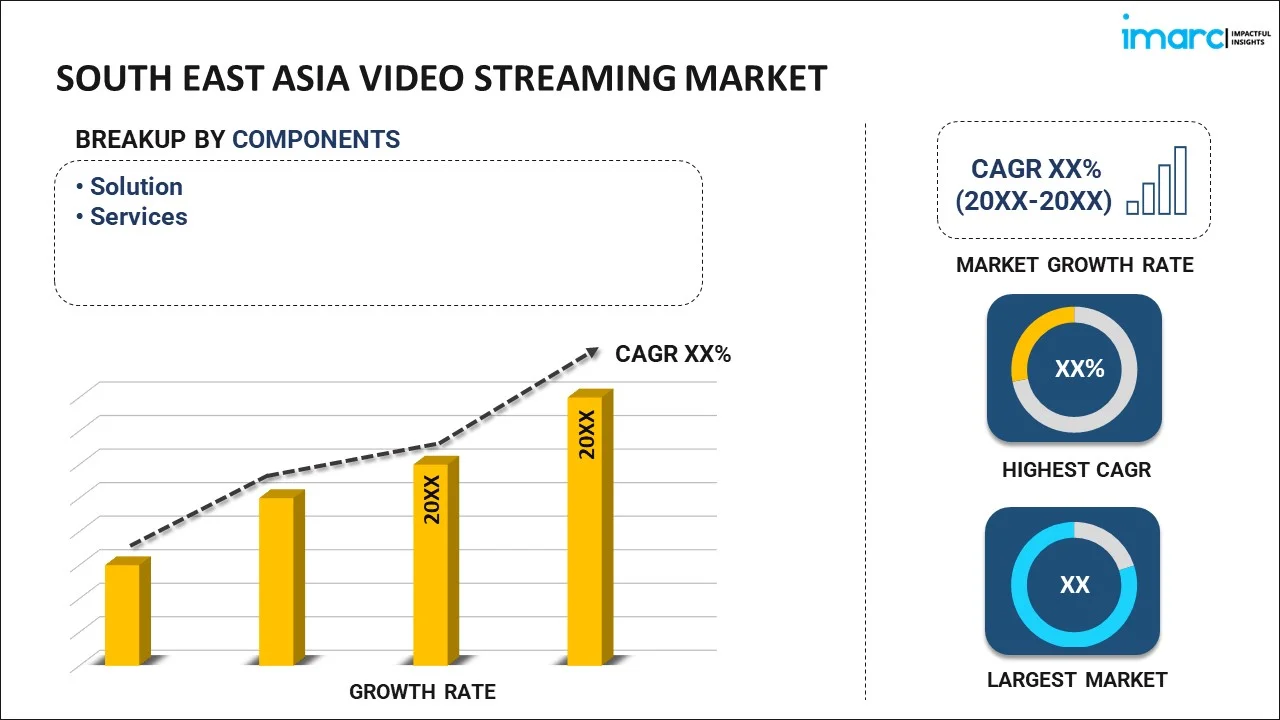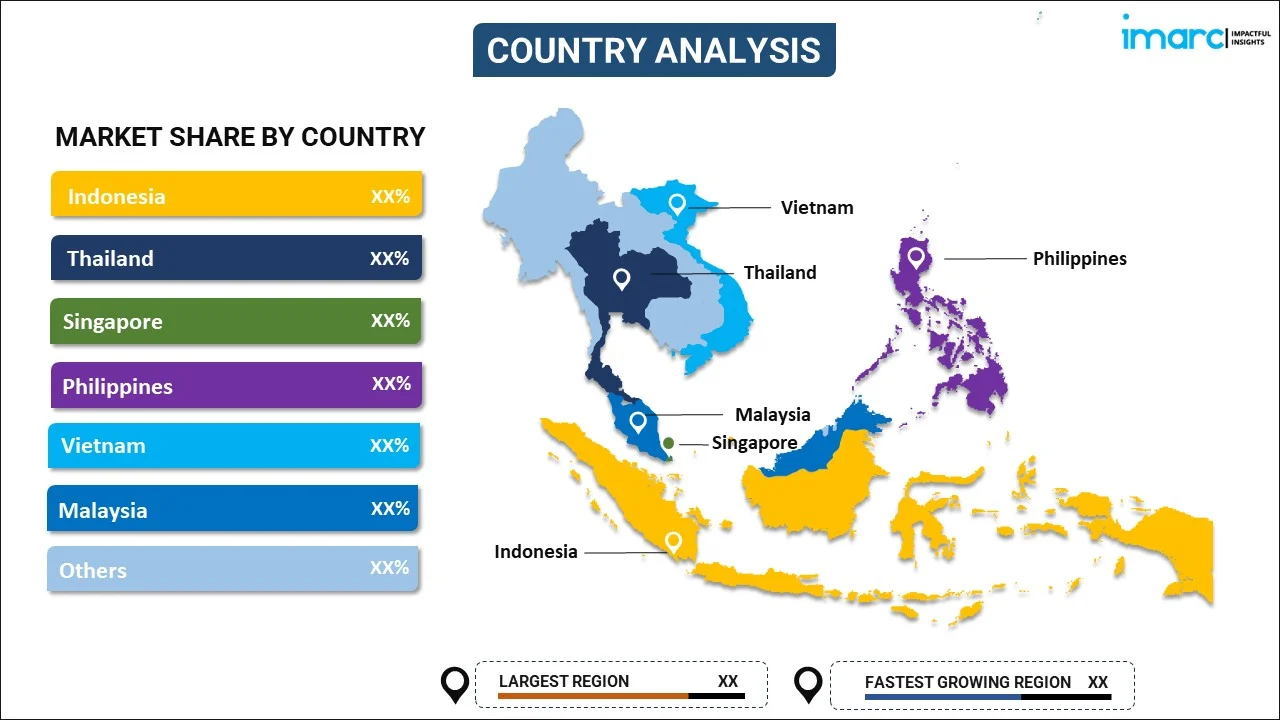
South East Asia Video Streaming Market Report by Component (Solution, Services), Streaming Type (Live/Linear Video Streaming, Non-Linear Video Streaming), Revenue Model (Subscription, Transactional, Advertisement, Hybrid), End User (Personal, Commercial), and Country 2025-2033
Market Overview:
South East Asia video streaming market size reached USD 3.9 Billion in 2024. Looking forward, IMARC Group expects the market to reach USD 10.0 Billion by 2033, exhibiting a growth rate (CAGR) of 10.91% during 2025-2033. The growing proliferation of over-the-top (OTT) platforms, increasing availability of high-speed internet connectivity, and rising affordability and accessibility of smart devices and televisions (TVs) represent some of the key factors driving the market.
|
Report Attribute
|
Key Statistics
|
|---|---|
|
Base Year
|
2024
|
|
Forecast Years
|
2025-2033
|
|
Historical Years
|
2019-2024
|
|
Market Size in 2024
|
USD 3.9 Billion |
|
Market Forecast in 2033
|
USD 10.0 Billion |
| Market Growth Rate 2025-2033 | 10.91% |
Video streaming is the process of sending or sharing video content in a continuous flow over the internet. It comprises on-demand streaming, where users choose what they want to watch, and the content is streamed instantly. It also consists of live streaming, where content is broadcast in real-time, allowing viewers to watch events as they happen, such as live sports broadcasts or live gaming streams on platforms. It encompasses peer-to-peer streaming, which is a decentralized approach and enables viewers to share portions of the video with others, reducing the load on central servers. It relies on content delivery networks (CDNs) that play a crucial role in distributing content to multiple servers across the globe. This reduces latency and ensures smoother playback. It is integrated with adaptive bitrate streaming, which manipulates the quality of the video as per the internet connection of the viewer, ensuring a consistent viewing experience. Video streaming has made it possible to reach a global audience, breaking down geographical barriers. It enables users to watch content on their preferred devices anytime and anywhere, making it incredibly convenient. It also fosters real-time interaction, enabling engagement with viewers through comments and chats.
South East Asia Video Streaming Market Trends:
At present, the increasing proliferation of high-speed internet connectivity represents one of the crucial factors impelling the growth of the market in South East Asia. The advent of 5G technologies is improving data transmission speeds, enabling seamless and high-quality video streaming on various devices. This accessibility is opening new avenues for viewers to engage with video content. Besides this, the rising popularity of over-the-top (OTT) platforms is improving content delivery, disrupting traditional cable and satellite television models. The shift in preferences of individuals toward personalized and convenient viewing experiences is contributing to the market growth in the region. In addition, the growing diversification of content offerings is positively influencing the market. Streaming platforms are investing heavily in creating a diverse range of content, including original series, documentaries, and exclusive films. Apart from this, increasing initiatives to enhance content recommendations, personalize user experiences, and optimize content delivery is supporting the market growth. AI-driven algorithms analyze user behavior, preferences, and viewing patterns to suggest content tailored to individual tastes, thereby improving user engagement and satisfaction. Additionally, the rising affordability and accessibility of smart devices and televisions (TVs) are bolstering the market growth in the region. Moreover, streaming services are partnering with telecom operators, device manufacturers, and content creators to broaden their reach and enhance their value propositions. These collaborations enable companies to tap into new markets, leverage existing user bases, and offer bundled services that cater to diverse needs.
South East Asia Video Streaming Market Segmentation:
IMARC Group provides an analysis of the key trends in each segment of the market, along with forecasts at the regional and country level for 2025-2033. Our report has categorized the market based on component, streaming type, revenue model, and end user.
Component Insights:

- Solution
- IPTV
- Over-the-top
- Pay TV
- Services
- Consulting
- Managed Services
- Training and Support
The report has provided a detailed breakup and analysis of the market based on the component. This includes solution (IPTV, over-the-top, and pay TV) and services (consulting, managed services, and training and support).
Streaming Type Insights:
- Live/Linear Video Streaming
- Non-Linear Video Streaming
A detailed breakup and analysis of the market based on the streaming type have also been provided in the report. This includes live/linear video streaming and non-linear video streaming.
Revenue Model Insights:
- Subscription
- Transactional
- Advertisement
- Hybrid
The report has provided a detailed breakup and analysis of the market based on the revenue model. This includes subscription, transactional, advertisement, and hybrid.
End User Insights:
- Personal
- Commercial
A detailed breakup and analysis of the market based on the end user have also been provided in the report. This includes personal and commercial.
Country Insights:

- Indonesia
- Thailand
- Singapore
- Philippines
- Vietnam
- Malaysia
- Others
The report has also provided a comprehensive analysis of all the major regional markets, which include Indonesia, Thailand, Singapore, Philippines, Vietnam, Malaysia, and Others.
Competitive Landscape:
The market research report has also provided a comprehensive analysis of the competitive landscape in the market. Competitive analysis such as market structure, key player positioning, top winning strategies, competitive dashboard, and company evaluation quadrant has been covered in the report. Also, detailed profiles of all major companies have been provided.
South East Asia Video Streaming Market Report Coverage:
| Report Features | Details |
|---|---|
| Base Year of the Analysis | 2024 |
| Historical Period | 2019-2024 |
| Forecast Period | 2025-2033 |
| Units | Billion USD |
| Scope of the Report | Exploration of Historical Trends and Market Outlook, Industry Catalysts and Challenges, Segment-Wise Historical and Future Market Assessment:
|
| Components Covered |
|
| Streaming Types Covered | Live/Linear Video Streaming, Non-Linear Video Streaming |
| Revenue Models Covered | Subscription, Transactional, Advertisement, Hybrid |
| End Users Covered | Personal, Commercial |
| Countries Covered | Indonesia, Thailand, Singapore, Philippines, Vietnam, Malaysia, Others |
| Customization Scope | 10% Free Customization |
| Post-Sale Analyst Support | 10-12 Weeks |
| Delivery Format | PDF and Excel through Email (We can also provide the editable version of the report in PPT/Word format on special request) |
Key Questions Answered in This Report:
- How has the South East Asia video streaming market performed so far and how will it perform in the coming years?
- What has been the impact of COVID-19 on the South East Asia video streaming market?
- What is the breakup of the South East Asia video streaming market on the basis of component?
- What is the breakup of the South East Asia video streaming market on the basis of streaming type?
- What is the breakup of the South East Asia video streaming market on the basis of revenue model?
- What is the breakup of the South East Asia video streaming market on the basis of end user?
- What are the various stages in the value chain of the South East Asia video streaming market?
- What are the key driving factors and challenges in South East Asia video streaming?
- What is the structure of the South East Asia video streaming market and who are the key players?
- What is the degree of competition in the South East Asia video streaming market?
Key Benefits for Stakeholders:
- IMARC’s industry report offers a comprehensive quantitative analysis of various market segments, historical and current market trends, market forecasts, and dynamics of the South East Asia video streaming market from 2019-2033.
- This research report provides the latest information on the market drivers, challenges, and opportunities in the South East Asia video streaming market.
- Porter's five forces analysis assist stakeholders in assessing the impact of new entrants, competitive rivalry, supplier power, buyer power, and the threat of substitution. It helps stakeholders to analyze the level of competition within the South East Asia video streaming industry and its attractiveness.
- A competitive landscape allows stakeholders to understand their competitive environment and provides an insight into the current positions of key players in the market.
Need more help?
- Speak to our experienced analysts for insights on the current market scenarios.
- Include additional segments and countries to customize the report as per your requirement.
- Gain an unparalleled competitive advantage in your domain by understanding how to utilize the report and positively impacting your operations and revenue.
- For further assistance, please connect with our analysts.
 Inquire Before Buying
Inquire Before Buying
 Speak to an Analyst
Speak to an Analyst
 Request Brochure
Request Brochure
 Request Customization
Request Customization




.webp)




.webp)












